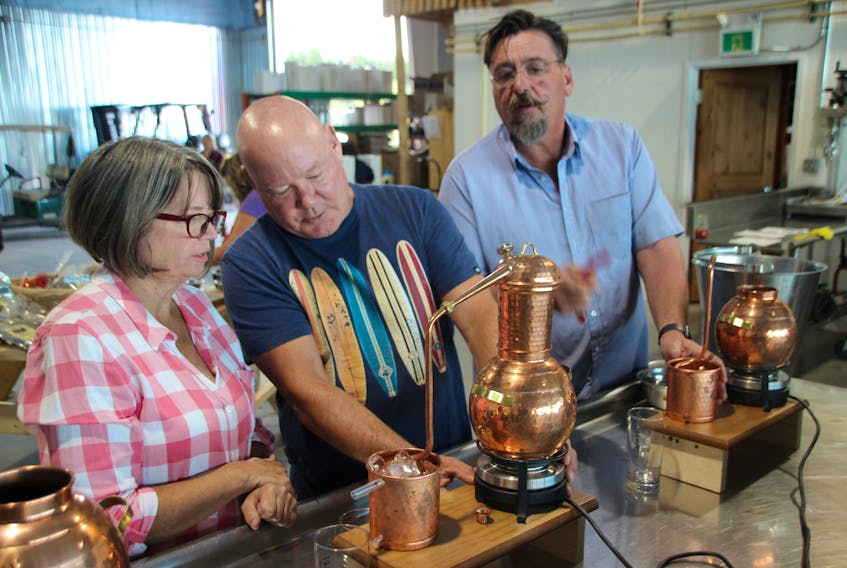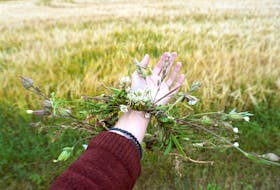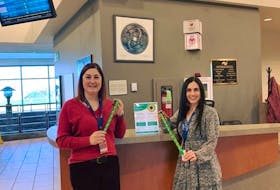Thomas Steinhart holds his pinky beneath the spout of my mini, two-litre still to catch a drop of the gin I’m cooking up.
I’ve gone with a spicy citrus blend of botanicals that are heavy on the grapefruit and orange peel, with the addition of what I hope is a balance of sweet spices like cardamom, cinnamon, anise, and angelica root.
After tasting the smear of gin on his finger, Steinhart declares it suitable for a good gin and tonic, but too busy for a martini.

I’m in the middle of the weekend-long GINstitute By the Sea at Steinhart Distillery in Arisaig on Nova Scotia’s north shore. Wayne Johnson, who’s running the experience for Steinhart, says, “Thomas makes a classic style of gin with fewer botanicals. When it comes to martinis, purists don’t want all that – as they call it – herb garden.”
I selected my herb garden ingredients from among a couple of dozen items spread out on a nearby table. This is where Johnson led me and three others through the process of selecting, weighing, and preparing the botanicals. I started with a generous 30 grams of juniper berries and seven grams of coriander seeds.
“Juniper is vital,” Steinhart told us. “Coriander is important, so don’t be shy.”
The juniper is imported from Italy where the Tuscan sun infuses the berries with loads of flavour. Although juniper grows wild in Nova Scotia, our season isn’t long enough to produce berries suitable for flavouring gin.

With a mortar and pestle, we ground the berries and seeds, before tossing them into the still pot. Johnson filled each with a 30 per cent flavourless alcohol made at the distillery from red winter wheat grown in PEI.
“Gin starts as vodka,” Steinhart explained. “Vodka making is a science. Gin making is an art.”
German traditions

Next, we placed the remaining ingredients like citrus peel, cinnamon sticks, ground cardamom, and dried orange flowers into the aroma basket that fits into the top of the still. Vapours from the alcohol, juniper, and coriander mix pass through the other ingredients on their way to the condenser.
Steinhart doesn’t look the part of the artist. He’s a big man with a deep voice and a hearty appetite. In a couple of bites, he scoffed a plate of traditional schnitzel and spaetzel from the outdoor restaurant next to his distillery, a meal that comes with the GINstitute experience. But his handlebar moustache, tapered to a point, does fit his background as a mechanical engineer, millwright, and German immigrant from a long line of distillers.
“I learned distilling from my grandfather in Germany,” Steinhart says. “He had a farm, and if you have a farm, you have a still.”


As a boy, Steinhart started by washing bottles and stoking the wood fire. When his grandfather was satisfied that he knew the process well enough, he permitted Steinhart to distill on his own.
Each farm, like his grandfather’s, was granted an annual quota of 1,000 litres or so. “Everybody made more than they were allowed to, and everybody got caught,” Steinhart recalls.
Everybody, that is, except his clever grandfather.
“He painted milk jugs white inside. Everybody tried to sneak them into the bars at night, but he delivered milk and booze during the day with a little wagon.”
He and his grandfather made fruit brandies called schnapps, but it was gin that they perfected. Since start-up in 2012, Steinhart’s gin and distillery have won major awards in San Francisco, New York, and Berlin. The exclusive Gin Guild in England granted Steinhart the title Warden Rectifier. He’s the first – and, as far as he knows, the only - gin maker in the Americas so recognized
So, it’s no wonder that from a single drop, Steinhart can detect the ingredients in my unique gin recipe and suggest the best way to drink it. He repeats his assessment at each of the other four stations.
‘The ginny pigs’

The five of us spend the morning tending our mini stills, keeping the temperature between 80 and 90 degrees Fahrenheit, continuously adding ice to the condensing pot, emptying the meltwater, and carefully pouring off the accumulated gin into a bottle.
In the shadow of the full-sized, 1,200 litre still, we go about our work, mirroring that of Steinhart himself when he crafts single batches of gin and other spirits by hand.

Our mini stills compress the time and number of steps involved in making a truly fine gin like Steinhart’s. In three or four hours, our bottles are nearly filled with gin. It’s now at over 70 per cent alcohol, so, using an alcohol meter as his guide, Johnson adds water to drop the alcohol level to about 50 per cent. Any lower and the oils from the botanicals become visible, resulting in cloudy gin.
At last, it’s time for drinks. We grab a classic gin and tonic from the bar and head outside to the picnic tables and Adirondack chairs. The distillery sits atop a hill with a million dollar view of the Arisaig lighthouse and wharf where fishing boats tie-up between trips. Before us stretches the Northumberland Strait all the way to P.E.I.

We review our GINstitute experience with Johnson and decide it’s a real winner, but it needs a little honing. The introduction, instructions, guidance, and access to the ingredients all need streamlining. But this is just its first summer, and as one of the participants put it, “We’re the ginny pigs.”
I order a burger from the restaurant – this is Steinhart’s, so of course it’s a schnitzel burger – then sit back to sip world-class gin. Not mine, which is good for mixing. It’s Steinhart’s, made with the wisdom and artistry of generations.








